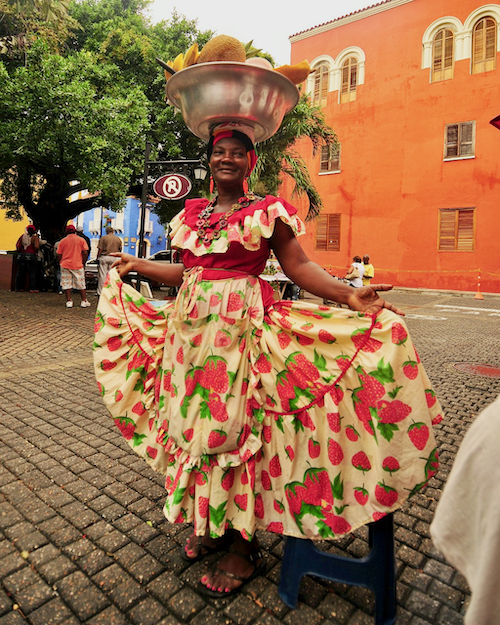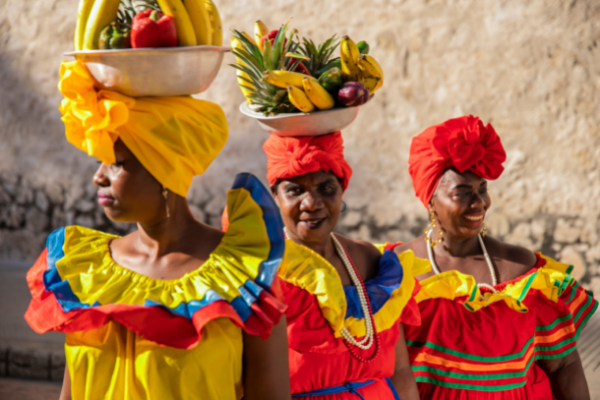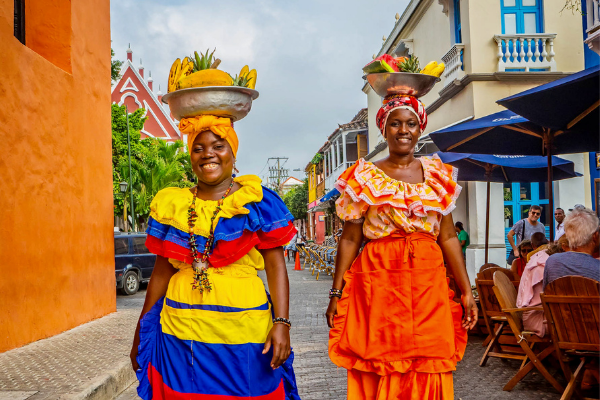COLOMBIA
Las Palenqueras
By Jorge Mendez Urrea
Colegio Nueva Granada | Bogotá, Colombia
On June 1, 1533, a Spanish conquistador founded the port city of Cartagena on the Caribbean coast of Colombia. Archaeological evidence suggests that Indigenous communities had lived in the area as far back as 4,000 BCE. During the Spanish Colonial era, the city became a hub for economic and political development.
In Search of Freedom
Because Cartagena grew into a major trade center during the 16th and 17th centuries, Spanish ships carrying enslaved Africans often docked there. Some of the captives managed to break free. They fled and established a village 50 kilometers to the southeast, which they called Palenque de San Basilio. The word palenque means “walled city.”
Palenque de San Basilio’s residents embarked on a mission: free all the enslaved people that arrived in Cartagena. They were eventually successful. In 1691, King Charles II of Spain decreed it an independent settlement as long as it harbored no new escapees. This proclamation established Palenque de San Basilio as the first officially free town in the Americas.
Who Are the Palenqueras?
To earn a living, women in the town harvested fresh fruit from the jungle. They filled baskets with their bounty and traveled to Cartagena to sell it on the streets. As this practice spread, the women became known as palenqueras.
 Cartagena has many tourist attractions, such as colorful colonial buildings, plazas, castles, cathedrals, and a historic center. But the palenqueras are one of its best-known symbols.
Cartagena has many tourist attractions, such as colorful colonial buildings, plazas, castles, cathedrals, and a historic center. But the palenqueras are one of its best-known symbols.
They have become icons due to their smiles, their bright clothing, and the variety of fruit they offer. As they pass through the city, they spread delicious aromas of tropical flavors found in mangoes, bananas, papayas, and more.
Palenqueras are captivating not only as visual symbols but also for their skill at balancing great quantities of fruit on their heads. Head-carrying is a way to maintain their African roots and show cultural pride. Palenqueras represent more than a city. They are evidence of a culture that has thrived despite the odds.
Have a suggestion for this story? We’d love for you to submit it!


Blank
Blank
Math Resources
- Early Elementary School: If a palenquera woman has one papaya, five bananas, one pineapple, two watermelons, and four mangoes, how many pieces of fruit is she carrying?
- Elementary School: A group of six palenquera women carry 48 pieces of fruit all together. If they are each carrying the same number of fruit, how many pieces are they each carrying?
- Middle School: Josh wants to find out how much fruit a palenquera is carrying, but he is not able to count it properly. Determined, Josh approaches another palenquera who is carrying three pieces of fruit. He estimates that this palenquera is carrying one-third of the fruit the other one was carrying. How many pieces of fruit is the original palenquera carrying?
- High School: A supermarket sells papayas of equal volumes. Jasmin, a palenquera, decides she wants to carry only papayas today. If her half-spherical basket has a radius of six inches, and the papayas have a volume of 50π, how many papayas could Jasmin fit in her basket?
Social Justice Questions
Palenque de San Basilio is the only walled settlement of escaped slaves to exist today. Residents identify themselves as African first and Colombian second. Their shared history of freedom-fighting binds them together in a unique way.
- What do you think is the effect on today’s descendants of that history?
- How would your community be different if everyone’s ancestors had been kidnapped, brought to another continent, and then escaped?
Explore Further
- Article about the palenqueras in Spanish
- African history of Palenque de San Basilio
- History of settlements like Palenque de San Basilio in the US
- UNESCO’s listing of Palenque de San Basilio as a Masterpiece of the Oral and Intangible History of Humanity
- More information about Palenque de San Basilio’s unique culture
- Video interviews of palenqueras
Share Your Story
Write your own Global Math Story and send it to us!
Sorry, the comment form is closed at this time.